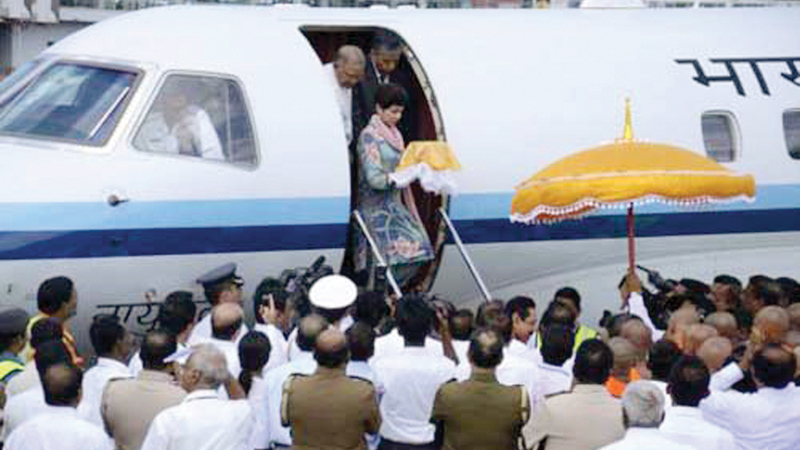Religion has been part of the foreign policies of Christian and Islamic nations for a long time. As is well known, one of the goals of the foreign policy of Western colonial powers was to spread Christianity and “civilise” the world, the sword in one hand and the bible in the other, as it were.
In the medieval era, spreading Islam through proselytisation was the core objective of expansionist Islamic forces. Vast areas from Spain in the West, through Central Asia and to Afghanistan and Xinjiang in the East came under the sway of Islam.
In recent times, the US and its Western allies encouraged radical Islamic forces to overthrow progressive, but anti-West regimes in Iran and Afghanistan and set up regimes friendly to them.

Dr. Sarita Dash
In contrast, Buddhism and Hinduism crossed the boundaries of their lands of origin and development, not by being instruments of foreign policy, but via peaceful international trade. Most of Asia is today Buddhist in one way or another, and that is because bhikkhus from India latched on to Indian traders in South East and East Asia and spread the word of the Buddha.
The subsequent rise of the Arab and European traders in Asian trade ended the dominance of the Hindu/Buddhist traders and Buddhist expansion was curtailed.
Emerging India
However, after the collapse of colonialism post World War II, emerging India (and China much later on) began to use Buddhism to reach out to Asian countries that are predominantly Buddhist. Buddhism was harnessed to serve India’s foreign policy ends.
Though neither India nor China is a Buddhist country (India is predominantly Hindu and China is officially atheist) both use their Buddhist past and their earlier contribution to the development of Buddhist thought and action as a foreign policy tool.
Buddhism is so important in China’s Asia policy that it has been made a part of its flagship project, the multi-billion dollar Belt and Road Initiative (BRI). On December 12, the 8th ‘South China Sea Buddhism Roundtable’ took place in Colombo. It was attended by over 400 bhikkhus, scholars, government officials and representatives from all walks of life from 25 countries and regions including China, Sri Lanka, Cambodia, Japan, India, Vietnam, the United States and France.
It was the first time that the Roundtable in its entirety was held outside China. Vice President of the Buddhist Association of China and Abbot of the Shenzhen Hongfa Temple Master Yinshun delivered the keynote speech.
From the 1950s, India has been using Buddhism to project an image of being a civilisation wedded to peace and reconciliation. Its first Prime Minister Jawaharlal Nehru chose the Ashoka Chakra as the national symbol and his government celebrated the Buddha Jayanti as an international event in 1956. Many Sri Lankans were invited to attend.
In the 1990s, Prime Minister P. V. Narasimha Rao inaugurated the Look East Policy (LEP). After Narendra Modi became PM, it was re-designated as Act-East Policy (AEP). Though the LEP and AEP were and are essentially trade, investment and connectivity oriented cultural and religious ties have been given equal importance because culture and religion helped facilitate people-to-people relations which are the bedrock of international relations.
In her comprehensive work entitled Cultural Dimensions of India’s Look-Act East Policy (Palgrave McMillan) Dr. Sarita Dash of Jawaharlal University in New Delhi says that India has been using Buddhism in its relations with Mynamar for decades. India helped restore the Ananda Temple in Bagan. In 2012, the then External Affairs Minister Salman Khurshid inaugurated the International Conference on Buddhist Heritage in Yangon.
Festival of India
In March 2014, the ten-day “festival of India in Thailand” provided glimpses of the Buddha’s life through eye-catching statuettes, panels and pictures. The exhibition travelled to Bangkok, after creating waves in Laos, Cambodia and Vietnam, Sarita Dash recalls.
Under the Narendra Modi Government, ‘Buddhist Connect’ has been made a critical component of the Act East Policy. Modi has made efforts to develop his home town Vadnagar in Gujarat, which is associated with the Buddha, as a Buddhist pilgrimage centre.
The New Delhi-based International Buddhist Confederation (IBC) organised the “International Buddha Poornima Diwas” with Modi as its main invitee in May 2015. Later in September, the IBC co-organised the international “Global Hindu-Buddhist Initiative on Conflict Avoidance and Environment Consciousness” conference, with Modi’s participation.
“In 2015, Modi made the first-ever announcement of making the Buddha Purnima an official holiday and started presenting an array of symbolic gifts including saplings of the original Bodhi tree in Gaya to East Asian nations. Before him, former PM Manmohan Singh had gifted a Bodhi sapling to the Thai king in 2013 and former President Pranab Mukherjee planted a Bodhi sapling in Hanoi, Vietnam, 2014,” Sarita Dash says.
To attract Buddhist pilgrims from East and Southeast Asia, India is being transformed into a global Buddhist pilgrimage site. A “Buddhist Tourist Circuit” has been worked out which covers Lumbini and Kapilavastu in Nepal, Bodhgaya, Sarnath, Sravasti and Kushinagar in Uttar Pradesh, Rajgir, Nalanda and Vaishali in Bihar. The project is getting international funding. In January 2022, the Indian Railways launched a Buddhist Circuit Tourist train that covers four Buddhist destinations: Lumbini, Kushinagar, Bodhgaya (Gaya) and Sarnath.
Airport in Kushinagar
India recently opened an international airport in Kushinagar, which can be considered the centre of the Buddhist circuitm says Dr. Sarita Dash. As per the Indian Government, about 200–300 Buddhist pilgrims from Thailand, Cambodia, Japan and Myanmar visit Kushinagar on any given day.
There are proposals to promote historic Buddhist sites across 17 Indian states. For example, the Odisha Government has taken a keen interest in promoting Dhauli, the site where Emperor Ashoka won the bloody Kalinga war, but gave up war and accepted Buddhism in repentance.
The Archaeological Survey of India (ASI) renovated the Angkor Vat and Ta Prohm temples in Siem Reap, Cambodia; and the Vat Phou temple in Laos. It is also engaged in the conservation of the My Son group of temples in Vietnam.
India brought down the Buddha’s relics from Kapilavastu to Sri Lanka in 2012 for the public to venerate them. India has given a US$ 15 million grant to bolster Buddhist connections between India and Sri Lanka.
By dividing the state of Jammu and Kashmir and making Ladakh a Union Territory in 2019, Prime Minister Modi created a Buddhist-majority area. “It will not be mistaken to view this move as a plausible boost for Buddhist diplomacy,” Sarita Dash says.
For the first time, the MEA collaborated with the Gautam Buddha University (GBU) near Delhi to conduct a three-day course for ASEAN countries on India’s Buddhist heritage. The course was entitled: “Engaged Buddhism: A joint-way forward for India and ASEAN” and was designed for ASEAN diplomats, civil servants and academics.
Need for improvements
These valiant efforts notwithstanding, there are many shortcomings in the use of Buddhism in foreign policy, Dr. Sarita Dash says.
“Infrastructure and services at the Buddhist tourist spots are not world-class at present. The sorry state of services available, especially in Bodh Gaya, calls for better facilities. The undeniable fact is that the people of Bihar are mostly poor hosts to multitudes of Buddhist visitors. Therefore, New Delhi should make serious efforts, jointly with the concerned state governments, not only to develop India as an important Asian centre for Buddhist tourism and studies but also to elevate the quality of life of people in those tourist sites. Unless the latter happens, the former may not be possible to accomplish,” she says.
Connectivity is there but it should be upgraded through railways, highways and airways, connecting Buddhist spots from Lumbini on the Indo-Nepal border through Bodhgaya, Bharhut, Amaravati, Shravasti, Sankashaya, Nalanda and Rajgir, Lalitagiri and Ratnagiri along with Sanchi, Amaravati, Ajanta, Ellora, Kanheri and Karli, she says.
There is a lack of deeper understanding of Buddhist art, literature and philosophy in Indian universities, she says. Besides improving Nalanda University, the Government ought to elevate the standard of Buddhist Studies in Nava Nalanda Mahavihara in Bihar, in Sanchi University, and other Buddhist teaching and research institutions, Dr. Sarita Dash says.




